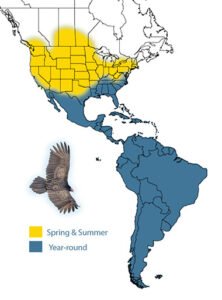
Turkey vultures are versatile when it comes to their habitat. They can adapt to various environments, from open countryside to urban areas. Their distribution spans much of North America, Central America, and even parts of South America. Understanding where turkey vultures live helps us appreciate their role in nature and the spaces they thrive in. So, let’s break down their habitats, distribution, and lifestyle to discover why these birds are so remarkable.
Natural Habitat of Turkey Vultures
Turkey vultures are quite adaptable to their surrounding environments. They typically prefer open or semi-open regions. This includes a mix of habitats like woodlands, grasslands, and even suburban areas. You might not expect to find them in cities, but they often do! They like wide spaces where they can soar high in the sky searching for food.
Interestingly, these birds are most commonly spotted in areas with plenty of food sources. They thrive in regions where carcasses are abundant. This could be farms, fields, or even near highways where animals might end up as roadkill. They rely on their keen sense of smell to locate their next meal, which is pretty rare among birds.
Geographical Distribution
Turkey vultures are widespread across North America, stretching from southern Canada all the way down to the tip of South America. During the summer months, they’re commonly found in the U.S. and southern Canada, migrating south as the weather cools down. This migration is quite impressive, as these birds can travel over 150 miles in a single day while searching for food and better climates.
In addition to North America, turkey vultures also inhabit parts of Central America and northern South America. This extensive geographical range is a testament to their adaptability and survival skills. You might find them even in the Caribbean islands, where their scavenging habits help manage local ecosystems.
Seasonal Movement and Migration
Now, you might be wondering how turkey vultures manage to stay comfortable throughout the seasons. As temperatures begin to drop in late fall, these birds start their migration southward. They usually gather in large flocks before starting their journey. It’s a sight you won’t forget—thousands of vultures taking to the sky together!
Their migration is not just about escaping the cold. It’s also crucial for their survival, as they follow food sources to ensure they have ample sustenance. Turkey vultures often migrate to warmer regions where dead animals are more readily available. When spring rolls around, they head back north, often returning to the same nesting areas year after year.
Preferred Nesting Locations
Finding a safe spot to nest is vital for the survival of turkey vultures. They prefer to find secluded areas where they can lay their eggs without disturbance. Unlike many birds, turkey vultures don’t build traditional nests. Instead, they often lay their eggs in sheltered spots, such as rocky crevices, hollow logs, or even abandoned buildings.
This nesting strategy helps keep their eggs safe from predators. Plus, the warm, dry spots are perfect for raising their young. Once the chicks hatch, both parents take turns feeding them, which is a wonderful example of parental cooperation in the animal kingdom.
Urban Adaptability
You might find it surprising, but turkey vultures can thrive in urban environments. As cities expand, they often create new habitats where these birds can forage. Areas with parks, golf courses, and even landfills can become turkey vulture hotspots. Their incredible ability to adapt allows them to take advantage of new food sources that urban areas provide.
In cities, they usually roost on tall buildings or trees, allowing them to spot potential food from high above. Their presence in urban areas often raises eyebrows, as many people associate vultures with death. However, remember that they’re simply playing their role in the ecosystem. Having them around helps manage waste by consuming dead animals that would otherwise become a public health concern.
Threats to Turkey Vultures
Despite their adaptability, turkey vultures still face various threats. Habitat destruction is a significant concern, as urbanization and agriculture can reduce the natural spaces they rely on. Additionally, they are at risk from poisoning due to consuming carcasses contaminated with toxins. Lead poisoning from ingested lead fragments in animal remains can be particularly harmful to these birds.
Moreover, climate change presents an evolving challenge. Changes in weather patterns can affect their food availability and migratory routes. If you love wildlife, it’s essential to keep an eye on our turkey vultures. Protecting their habitats ensures that they can continue doing their vital job in our environment.
The Role of Turkey Vultures in the Ecosystem
Turkey vultures are more than just scavengers; they play a crucial role in maintaining ecosystem balance. By consuming dead animals, they help prevent the spread of diseases that can occur when carcasses decay. In many ways, they’re like nature’s garbage disposals, providing a vital service that benefits all wildlife and humans alike.
Their presence indicates a healthy ecosystem. When turkey vultures are thriving, it often reflects a balanced environment with sufficient food sources. Moreover, they help recycle nutrients back into the soil, supporting the growth of plants and other organisms. So, every time you see a turkey vulture gliding in the sky, remember how important they are for keeping our world running smoothly.
Turkey vultures may not be the most glamorous birds, but they are undeniably important. From their adaptable habitats to their extensive distribution, these scavengers have carved out a niche that plays a vital role in our ecosystems. By understanding where turkey vultures live and how they thrive, we can better appreciate the complex relationships within nature.
So next time you see one circling overhead, take a moment to acknowledge their hard work! They’re not just flying around aimlessly; they’re out there doing their part to keep our environment clean and balanced. Let’s all do our part to protect these remarkable birds and their habitats, ensuring they continue to soar through our skies for generations to come.
